Special Report: Millions of abandoned oil wells are leaking methane, a climate menace by Nichola Groom with additional reporting by Ekaterina Golubkova in Moscow, Rania El Gamal in Riyadh, June 16, 2020, Reuters
SALYERSVILLE, Kentucky (Reuters) – In May 2012, Hanson and Michael Rowe noticed an overpowering smell, like rotten eggs, seeping from an abandoned gas well on their land in Kentucky. The fumes made the retired couple feel nauseous, dizzy, and short of breath.
Regulators responding to the leak couldn’t find an owner to fix it. J.D. Carty Resources LLC had drilled the well near the Rowes’ home in 2006 – promising the family a 12.5% royalty and free natural gas, which they never got. But Carty went bust in 2008 and sold the site to a company that was later acquired by Blue Energy LLC. Lawyers for both companies deny any responsibility for the leak. ![]() Most efficient way to save human life on earth, is to abolish the legal/judicial industry (which would solve the brutal police problems), globally. And would save hundreds of millions of women and children from rape and other abuses too.
Most efficient way to save human life on earth, is to abolish the legal/judicial industry (which would solve the brutal police problems), globally. And would save hundreds of millions of women and children from rape and other abuses too.![]()
A year later, Kentucky’s Division of Oil and Gas declared the well an environmental emergency and hired Boots & Coots Inc – the Texas contractor that doused oil-well fires after the Gulf War – to plug it. During the 40-day operation, the Rowes retreated to a trailer on their property and lived with no running water to escape the gases and noise. Regulators determined the leak was a toxic blend of hydrogen sulfide, a common drilling byproduct, and the potent greenhouse gas methane.
“I wouldn’t go through this again for $1 million,” said Hanson Rowe, who with his wife is suing the energy companies for compensation.
The incident, while extreme, reflects a growing global problem: More than a century of oil and gas drilling has left behind millions of abandoned wells, many of which are leaching pollutants into the air and water. And drilling companies are likely to abandon many more wells due to bankruptcies, as oil prices struggle to recover from historic lows after the coronavirus pandemic crushed global fuel demand, according to bankruptcy lawyers, industry analysts and state regulators. ![]() Best not to listen to them, in my view. The bankruptcies by oil and gas and frac’ers have been planned all along. That’s how they get rid of clean up. Oil/gas prices have nothing to do with it. Even if oil was 300 a barrel today, we’d be seeing the same law violating messes, everywhere, enabled by courts granting bankruptcy after bankruptcy. Judges could grow a pair, and start saying no, you clean up your toxic pollution first, then, I’ll let you walk via bankruptcy. Of course, oil patch white privilege would freak out on any judge who dares do right by public health and environment, and would demand that their politico buddies punt such judges from the bench.
Best not to listen to them, in my view. The bankruptcies by oil and gas and frac’ers have been planned all along. That’s how they get rid of clean up. Oil/gas prices have nothing to do with it. Even if oil was 300 a barrel today, we’d be seeing the same law violating messes, everywhere, enabled by courts granting bankruptcy after bankruptcy. Judges could grow a pair, and start saying no, you clean up your toxic pollution first, then, I’ll let you walk via bankruptcy. Of course, oil patch white privilege would freak out on any judge who dares do right by public health and environment, and would demand that their politico buddies punt such judges from the bench.![]()
Leaks from abandoned wells have long been recognized as an environmental problem, a health hazard and a public nuisance. They have been linked to dozens of instances of groundwater contamination by research commissioned by the Groundwater Protection Council, whose members include state ground water agencies.

IRK! GROUNDWATER PROTECTION COUNCIL REALITY CHECK! Too many members are oil and gas industry “regulators” (aka pimps) and controlled by that very industry. I expect there’d be thousands more drinking water/groundwater contamination cases by the oil and gas industry documented, if the council were not so deeply oil patch infiltrated.
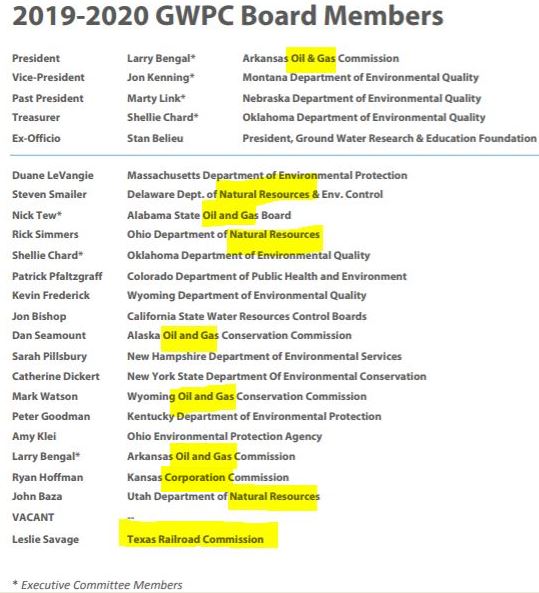

Orphaned wells have been blamed for a slew of public safety incidents over the years, including a methane blowout at the construction site of a waterfront hotel in California last year.
They also pose a serious threat to the climate that researchers and world governments are only starting to understand, according to a Reuters review of government data and interviews with scientists, regulators, and United Nations officials. The Intergovernmental Panel on Climate Change last year recommended that U.N. member countries start tracking and publishing the amount of methane leaching from their abandoned oil and gas wells after scientists started flagging it as a global warming risk. So far, the United States and Canada are the only nations to do so.
The U.S. figures are sobering: More than 3.2 million abandoned oil and gas wells together emitted 281 kilotons of methane in 2018, according to the data, which was included in the U.S. Environmental Protection Agency’s most recent report on April 14 to the United Nations Framework Convention on Climate Change. That’s the climate-damage equivalent of burning 16.2 million barrels of crude oil, according to an EPA calculation. That’s more than the United States, the world’s biggest oil consumer, uses in two days. (For a graphic on the rise in abandoned oil wells, click here )
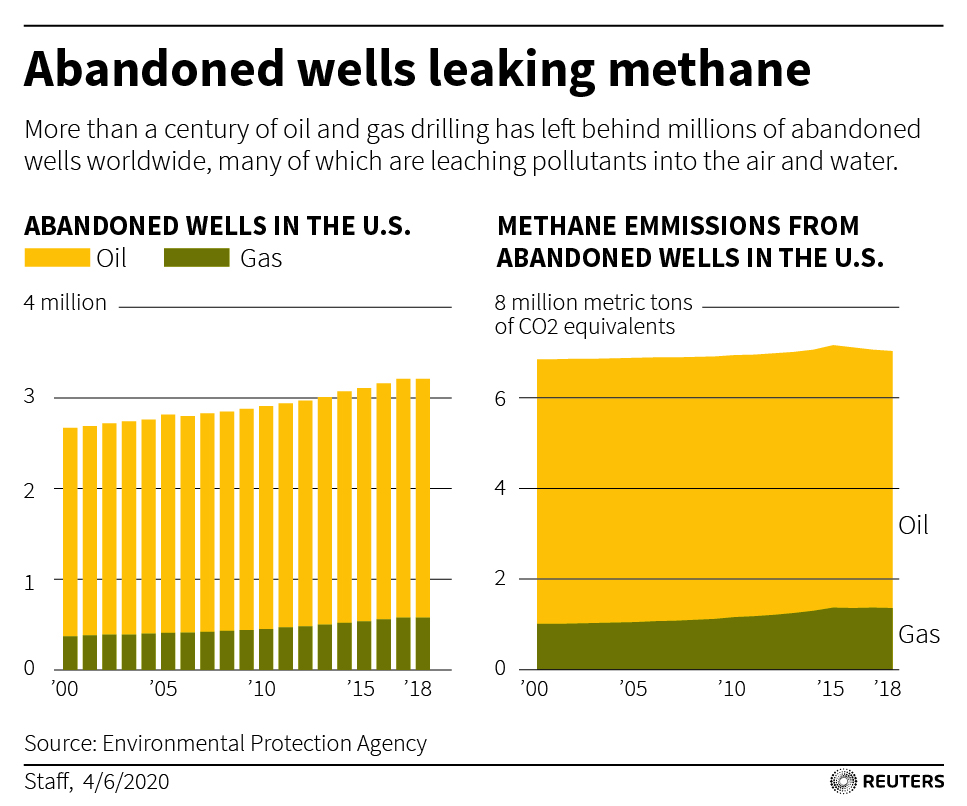
The actual amount could be as much as three times higher, the EPA says, because of incomplete data. The agency believes most of the methane comes from the more than 2 million abandoned wells it estimates were never properly plugged.
The problem is less severe in Canada, where the bulk of oil production comes from oil sands mining instead of traditional drilling. The government estimated that its 313,000 abandoned wells emitted 10.1 kt of methane in 2018, far less than in the United States. ![]() This is extremely inaccurate. Tarsands are only in one part in one province of Canada. Already back in 2003, regulators and Environmental Ministers of the Environment in Canada reported that there were 600,000 abandoned wells in Canada. Companies have abandoned many more wells since. They use the courts to make their walking from clean up legal.
This is extremely inaccurate. Tarsands are only in one part in one province of Canada. Already back in 2003, regulators and Environmental Ministers of the Environment in Canada reported that there were 600,000 abandoned wells in Canada. Companies have abandoned many more wells since. They use the courts to make their walking from clean up legal.
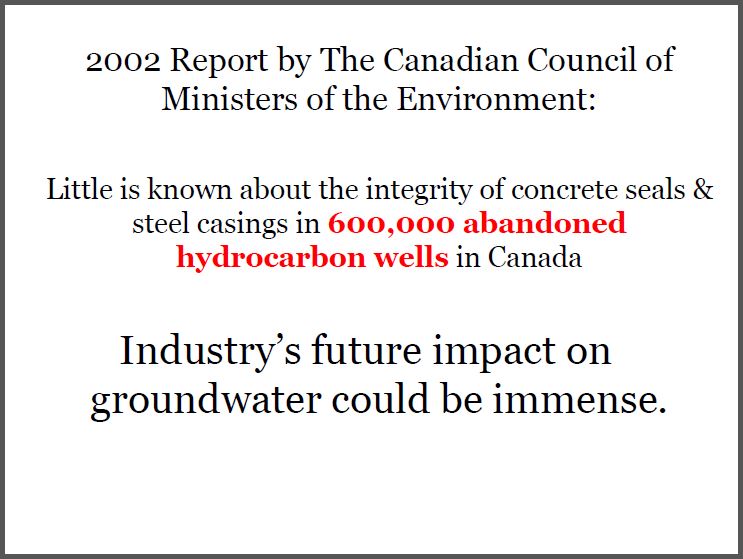
Above information from:
Groundwater Quality Canadian Council of Ministers of the Environment. Winnipeg, Manitoba. Linking Water Science to Policy Workshop Series. Report No.2, 52 pages. Crowe, A.S., K.A. Schaefer, A. Kohut, S.G. Shikaze, C.J. Ptacek. 2003
After Ernst went public with this damning report in her gas migration paper, and in numerous public talks, the gov’t (likely ordered so by CAPP/industry/Encana (now Ovintiv) removed it from public access. Ernst had saved a copy, and uploaded to this website because it’s vital information in the public interest.

The global impact is harder to measure. The governments of Russia, Saudi Arabia, and China – which round out the top five world oil-and-gas producers – did not respond to Reuters’ requests for comment on their abandoned wells and have not published reports on the wells’ methane leakage.
Researchers say it’s impossible to accurately estimate global emissions from leaky abandoned wells without better data. But a rough Reuters calculation, based on the U.S. share of global crude oil and natural gas production, would place the number of abandoned wells around the world at more than 29 million, with emissions of 2.5 million tonnes of methane per year – the climate-damage equivalent of three weeks of U.S. oil consumption.
HIDDEN MENACE
In a forested area of western New York state in February, a group of state regulators, along with researchers from the State University of New York at Binghamton, trudged through the snow. They stopped at a rotting wooden structure encircling a rusted pipe.
Department of Environmental Conservation (DEC) official Charlie Dietrich held a bright orange device over the heap. It emitted a high-pitched signal, and its screen showed a code indicating the presence of ignitable gas. A scent of petroleum wafted through the air.
“There’s some methane coming up out of there,” DEC Mineral Resources Specialist Nathan Graber said.
The abandoned well lies in the forests of Olean, New York, which was an oil boomtown at the turn of the 20th century. The site was one of 72 locations logged by geophysicists Tim de Smet and Alex Nikulin in December, researchers from Binghamton, using a drone equipped with a metal detector, part of a program launched in 2013 to help New York identify and plug abandoned wells.
New York’s DEC has records of 2,200 abandoned wells dating back to the late 1800s. But the state believes the actual number could be much higher, because of incomplete records.
“It’s a lot easier to find stuff when you know where to look,” Nikulin said.
The group is among an array of regulators, activists and federal agencies now seeking out abandoned wells from the U.S. Northeast to California. The heightened interest in the climate threat posed by the wells started with a 2014 study by Princeton graduate student Mary Kang, who was the first to measure methane emissions from old drilling sites in Pennsylvania. She concluded in 2016 that abandoned wells represent 5% to 8% of total human-caused methane emissions in the state.
“It’s not like they leak for one year, and then they stop,” said Kang, now a professor of civil engineering at McGill University in Montreal. “Some of these have been there maybe for 100 years. And they are going to be there for another 100 years.”
Although the Trump administration has downplayed global warming and its link to fossil fuels, the U.S. Energy Department has been financing efforts to improve data on emissions from abandoned wells. Researchers from DOE’s National Energy Technology Laboratory (NETL) recently took measurements from more than 200 wells in Kentucky and Oklahoma and are planning field work in Texas. They plan to publish their data by next spring.
NETL researcher Natalie Pekney said the work was crucial to better understanding the climate impact of abandoned wells. Many wells don’t leak much or at all, she said, while others have “huge” methane emissions.
NETL had previously used aerial surveys to locate old wells in Pennsylvania – home to the massive Marcellus gas deposit – so drillers could avoid pushing fluids and gases up through old abandoned well sites deep in the state’s forests. Its researchers found many old wells contained bubbling fluids, an indicator of methane leaks.
GROWING PROBLEM
Nationwide, the number of documented abandoned wells has jumped by more than 12% since 2008, around the start of the hydraulic fracturing boom, according to the EPA estimates. Many experts believe the number will keep growing.
Oil-and-gas firm bankruptcies in the United States and Canada rose 50% to 42 in 2019, and analysts say the rate is likely to accelerate as the pandemic-related slide in energy prices shakes out producers.
Research firm Rystad Energy estimates that about 73 U.S. drilling companies could go bankrupt this year, with an additional 170 succumbing in 2021, assuming an average oil price of $30 a barrel.
“When prices are this low, it becomes a very serious problem. It becomes a fight over who is going to ultimately have to pay” for cleaning up abandoned wells, said John Penn, a bankruptcy attorney with Perkins Coie LLP in Dallas. “It makes it really bad, and it’s going to get worse.” ![]() I call bullshit. In my view, companies intended to walk all along, with regulator/political/judicial blessings and would be walking even if prices for oil and gas were extremely high today. Companies were dumping what they didn’t want anymore when prices were at their highest, either selling to tiny fly-by-nights with zero ability to clean up, or just walking with “regulators” knowingly doing little, if anything, to stop them.
I call bullshit. In my view, companies intended to walk all along, with regulator/political/judicial blessings and would be walking even if prices for oil and gas were extremely high today. Companies were dumping what they didn’t want anymore when prices were at their highest, either selling to tiny fly-by-nights with zero ability to clean up, or just walking with “regulators” knowingly doing little, if anything, to stop them.![]()
A school district in Beverly Hills, California, was saddled with a bill of at least $11 million to plug 19 oil wells on the property of its high school, after a judge in 2017 absolved Venoco LLC – the bankrupt company that had been operating the wells – of any responsibility for clean-up because other creditors took priority. The city of Beverly Hills is contributing another $11 million to the job.
“This is an incredible amount of money” siphoned away from education, said Michael Bregy, superintendent of the Beverly Hills Unified School District.
State and federal regulations normally require drillers to pay an up-front bond to cover future cleanups if they go belly-up. But the rules are a patchwork, with wildly differing requirements, and they seldom leave governments adequately funded. In Pennsylvania, for example, it would take several thousand years to plug its estimated backlog of 200,000 abandoned oil wells at the current rate of spending, according to data from the state regulator.
Oil-industry lobbyists have been fighting state and federal efforts to increase the bonding, arguing it would hurt jobs and economic growth during an already tough time for the industry.
“States and the federal government have many sources of funding available to reclaim and plug abandoned wells,” said Reid Porter, a spokesman for the American Petroleum Institute, the country’s largest oil and gas trade group.
The API spent $1.44 million in the first quarter of 2020 lobbying on Capitol Hill, with oil well bonding legislation one of the target issues, lobbying disclosures show.
The U.S. Government Accountability Office estimates that cleaning up and plugging an abandoned well runs from $20,000 to $145,000, putting the price tag for cleaning up all of America’s abandoned wells somewhere between $60 billion to $435 billion.
‘SHOOTING OUT OF THE EARTH’
The pollution threat goes beyond climate change. Leaks from abandoned wells have been found to contaminate groundwater and soil. In extreme cases, gas from abandoned wells has caused explosions.
In Ohio and Texas, state regulators have each found an average of around two groundwater contamination incidents per year related to orphaned wells, according to research by the Groundwater Protection Council published in 2011 and dating to the 1980s. ![]() In my view, work by the Council is mostly pathetic incomplete shit, controlled by the very industry that doesn’t want to clean up after raping out billions in profits. I expect the council is is grossly under reporting the groundwater contamination cases to keep the industry happily getting away with raping us.
In my view, work by the Council is mostly pathetic incomplete shit, controlled by the very industry that doesn’t want to clean up after raping out billions in profits. I expect the council is is grossly under reporting the groundwater contamination cases to keep the industry happily getting away with raping us.![]()
In April 2017, for example, neighbors of Ohio farmer Stan Brenneman alerted him to the smell of oil coming from a drainage ditch on his 111-acre corn and soybean farm near the town of Elida, Brenneman told Reuters. The ditch drains water from the farm and carries it into rivers, streams and eventually Lake Erie.
Ohio’s Division of Oil & Gas Resources Management excavated 800 feet of the farm’s drainage system to find a well casing – about 130 years old – releasing oil three feet underground. The plugging operation took two months to complete and cost the state $196,915, according to a spokeswoman for the state Department of Natural Resources.
More recently, in 2018, the U.S. EPA was alerted to the presence of nearly 50 abandoned oil and gas wells on Navajo Nation lands within the borders of Utah and New Mexico that were bubbling water at the surface. Tests showed the way from some of the wells contained potentially dangerous levels of arsenic, sulfate, benzene and chloride.
The Navajo Nation Environmental Protection Agency said plugging the wells would require “major funds” and that, in the meantime, the public had been warned not to drink the water.
In rare cases, gas from long-abandoned wells can cause dangerous accidents.
In January of last year, a 1930s-era well sent a geyser of gas and dirt 100 feet into the air at the construction site of a Marriott seaside hotel in Marina del Rey, California, an upscale community in the Los Angeles area, according to a state report. The hotel owners did not respond to a request for comment.
“It was horrifying,” said resident Marilyn Wall, who witnessed the explosion from her home across the street. She said she was stunned “by the extent and the length of time that the stuff was shooting out of the earth.”
A worker standing on a construction platform above the plume was sprayed with debris and scrambled to lower himself down with an escape rope, a video of the explosion shows.
DON’T DRINK THE WATER
For Hanson and Michael Rowe, their troubles did not end the day their abandoned well was plugged. They no longer drink from the water well on their property because it gives them diarrhea, they said. Michael Rowe said she still suffers from headaches and coughing spells.
Kentucky’s Energy and Environment Cabinet is still fighting to recoup the $383,340 cost from the now-defunct J.D. Carty and Blue Energy in an ongoing court battle.
An attorney for John Carty, founder of J.D. Carty, said his client had sold what few assets remained in the company and therefore bore no responsibility. A lawyer for Blue Energy said the company denies ever operating the wells on the property and has no responsibility to maintain or plug them.
J.D. Carty was only required to have one $50,000 “blanket bond” to cover all its wells in Kentucky. The amount forfeited to pay for the leaky well on Rowe’s land, determined in part by its depth, was just $2,500 – less than 1% of the cost to fix it.
After the incident, Kentucky lawmakers passed a bill last year that effectively doubled bond requirements for shallow wells to help cope with the state’s 13,000 abandoned wells. Still, state regulators say the list of wells is growing.
Hanson Rowe said he supports fossil fuel development because using natural gas for heat and cooking has improved his quality of life. But the couple say they hope their lawsuit against the companies involved will help change the way the energy industry manages its wells.
“You lost your health, you’ve lost it all,” Hanson Rowe said.

Refer also to:
1985 Ross Dress for Less Explodes 13:20 Excellent Min.
Methane Gas Explosion from leaking abandoned oil field, Fairfax District Los Angeles, CA
1992: USA: Abandoned Oil and Gas Wells Become Pollution Portals
From the Louisiana bayous to the arid plains of Texas and Oklahoma, thousands of oil and gas wells, abandoned at the end of their productive life, have become conduits for noxious liquids that bubble up from deep below the earth’s surface to kill crops and taint drinking water. For state governments in America’s oil patch, these abandoned wells have become an expensive legacy left by a fading industry.
The Federal Environmental Protection Agency estimates that there are about 1.2 million abandoned oil and gas wells nationwide and that some 200,000 of them may not be properly plugged. In Texas alone, officials calculate there are 40,000 to 50,000 abandoned wells that could pose pollution problems.
Often drilled to depths of a mile or more, oil wells typically tap into sandy formations permeated with a brine that is up to four times saltier than sea water and that is laced with radioactivity, heavy metals and other toxins. Without extensive and costly plugging, that brine can flow up the well shaft and seep into fresh water aquifers or sometimes reach the surface. Occasionally the brine from abandoned wells hits the surface with explosive force.
In the last few years it has erupted through a parking lot in San Angelo, Tex. Mixed with natural gas, it spewed into the backyard of a home in Bartlesville, Okla., and oozed onto a freeway construction site in Tulsa. But the damage is usually slower and more insidious. A single unplugged exploration hole in West Texas leaked brine for 22 years before being discovered, polluting the ground water beneath 400 to 600 acres of land, a 1990 study by the Bureau of Economic Geology at University of Texas found.
… Water moves laterally across the aquifers, slowly but across great distances, to streams and creeks. … When the freshwater aquifer that supplied the central Oklahoma town of Cyril, population 1,200, was declared unsafe because of brine pollution in 1989, there was little doubt that the oilfield below it was at fault.
1996: Decades ago in Canada, Husky averaged costs to fix leakers as tabled:
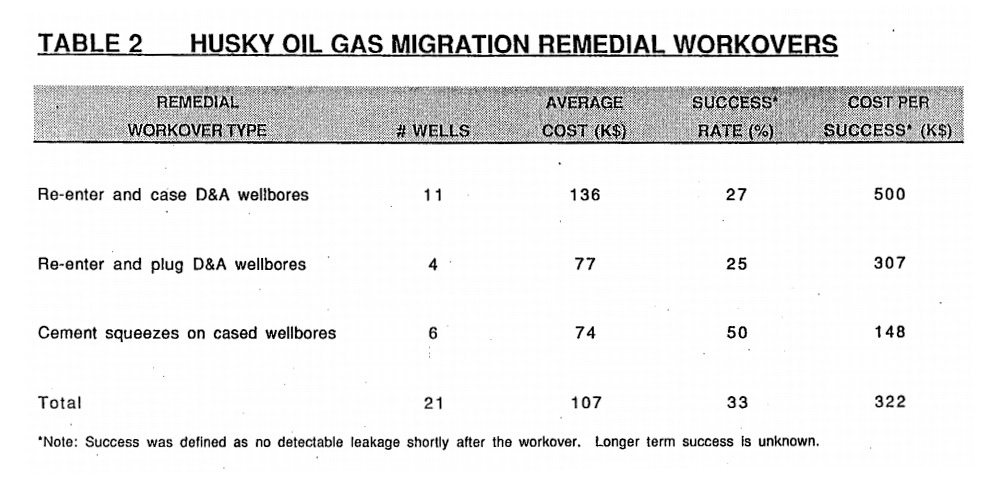
2002: Canadian Council of Ministers of the Environment: Groundwater Quality
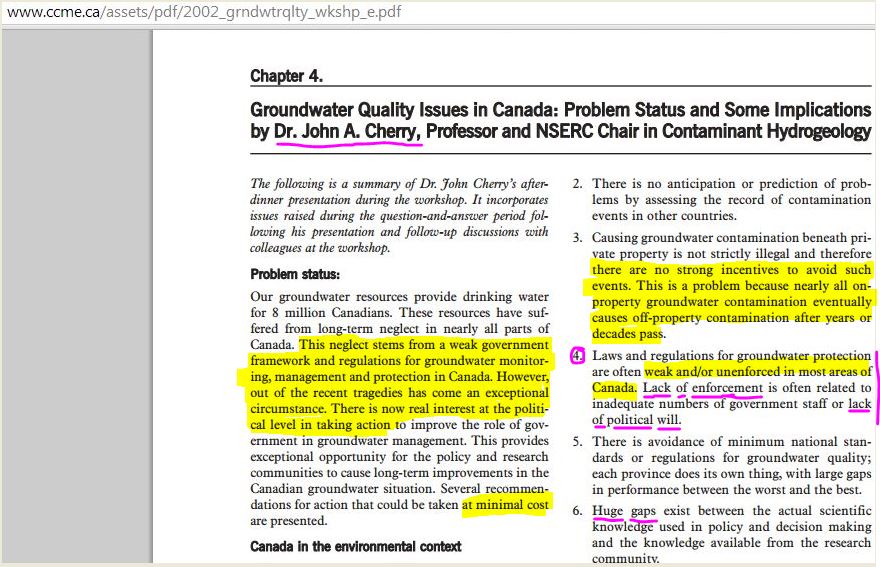
2012: Australia: Abandoned CSG wells ‘time bombs’
2014: Action needed on abandoned energy wells leaking methane in Quebec Action needed, all over the world, but the partriarchal, often misogynistic, rich white-privileged oil and gas with its rich white-privileged protective courts, politicians and regulators (also patriarchal and often misogynistic), make sure action never comes. Usually, as in the above story, the poor and or people of colour suffer the harms while the rich white-privileged get their buddies in the rich white male dominated courts to make legal the corporate thievery and abuse of families and the environment.
2015: Special Report: Uncovering abandoned oil and natural gas wells
2016: Colorado: Danger Below? New Properties Hide Abandoned Oil And Gas Wells
***
Proverb: Where there’s a will there’s a way.
There’s no will by companies to clean up. There never has been and never will be, other than the odd exception. They have to be made to clean up and since they’ve proven they will not and don’t give a damn about “polluter pay” laws, decade after decade after decade, the only solution is to make companies cough up the money before they drill & frac. If they can’t or won’t afford it, then refuse them licence.
Simple. But regulators and politicians and most NGOS don’t want anything to change either. The abusive polluting system fills their pockets, and keeps thousands of lawyers and judges well paid.
Why would companies clean up when nearly every authority and court is letting them burden the public with their law violations, health-harming pollution, lies, ill will, greed and disrespect, and hundreds of billions in clean up costs? How many dead and sick? How many frac’d aquifers, blown up water wells, homes, businesses that companies intentionally walk from, with blessings by authorities?![]()
